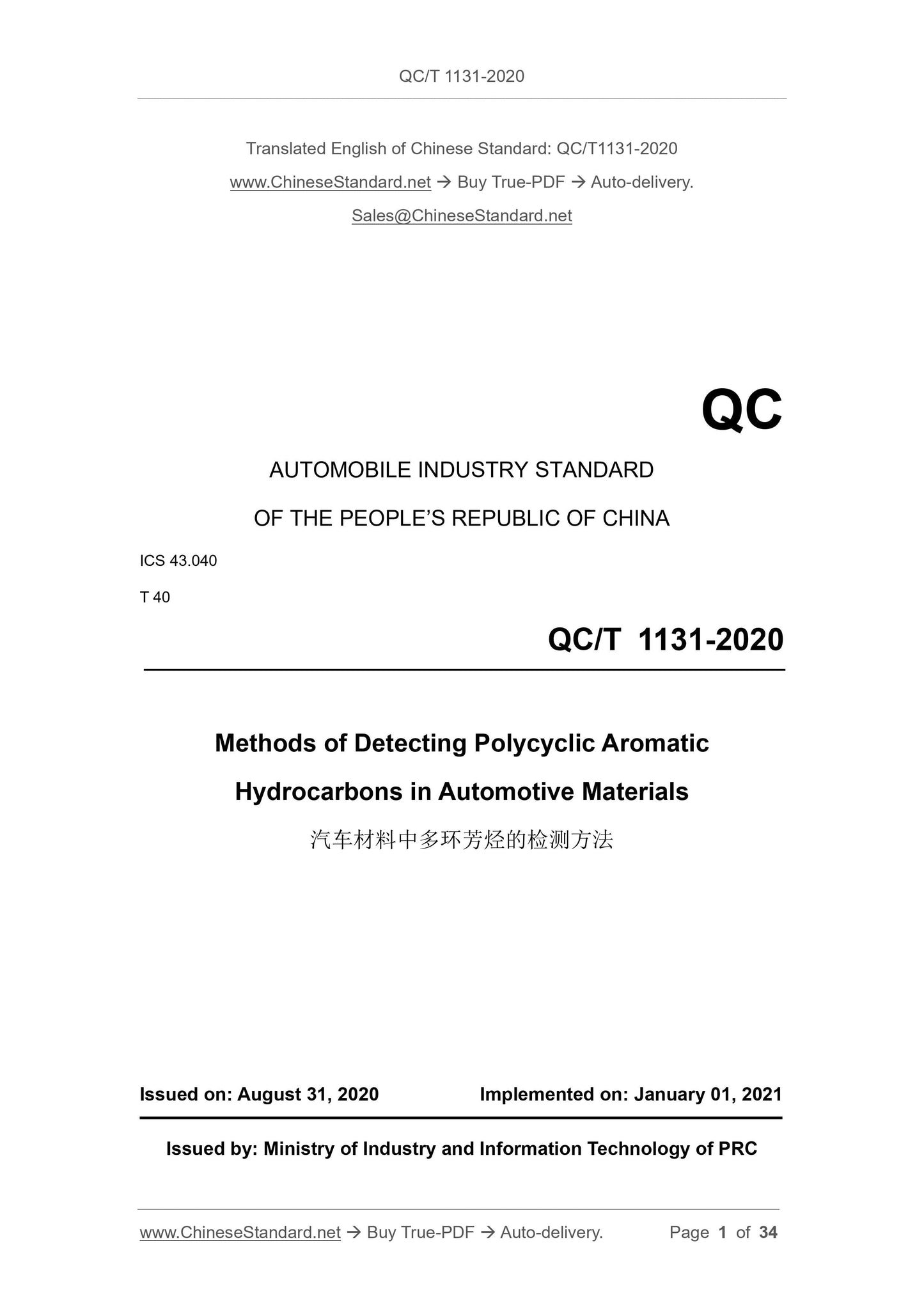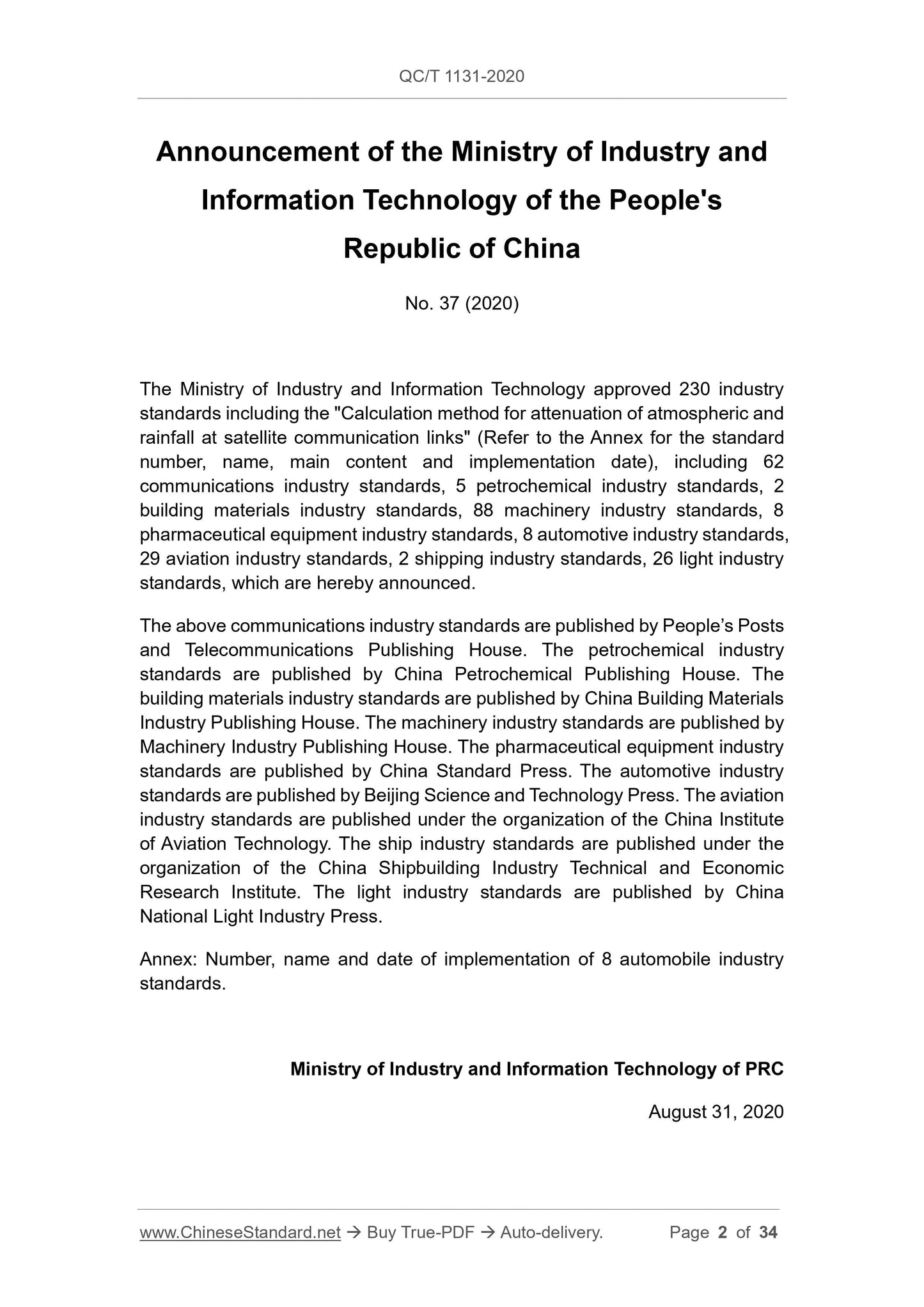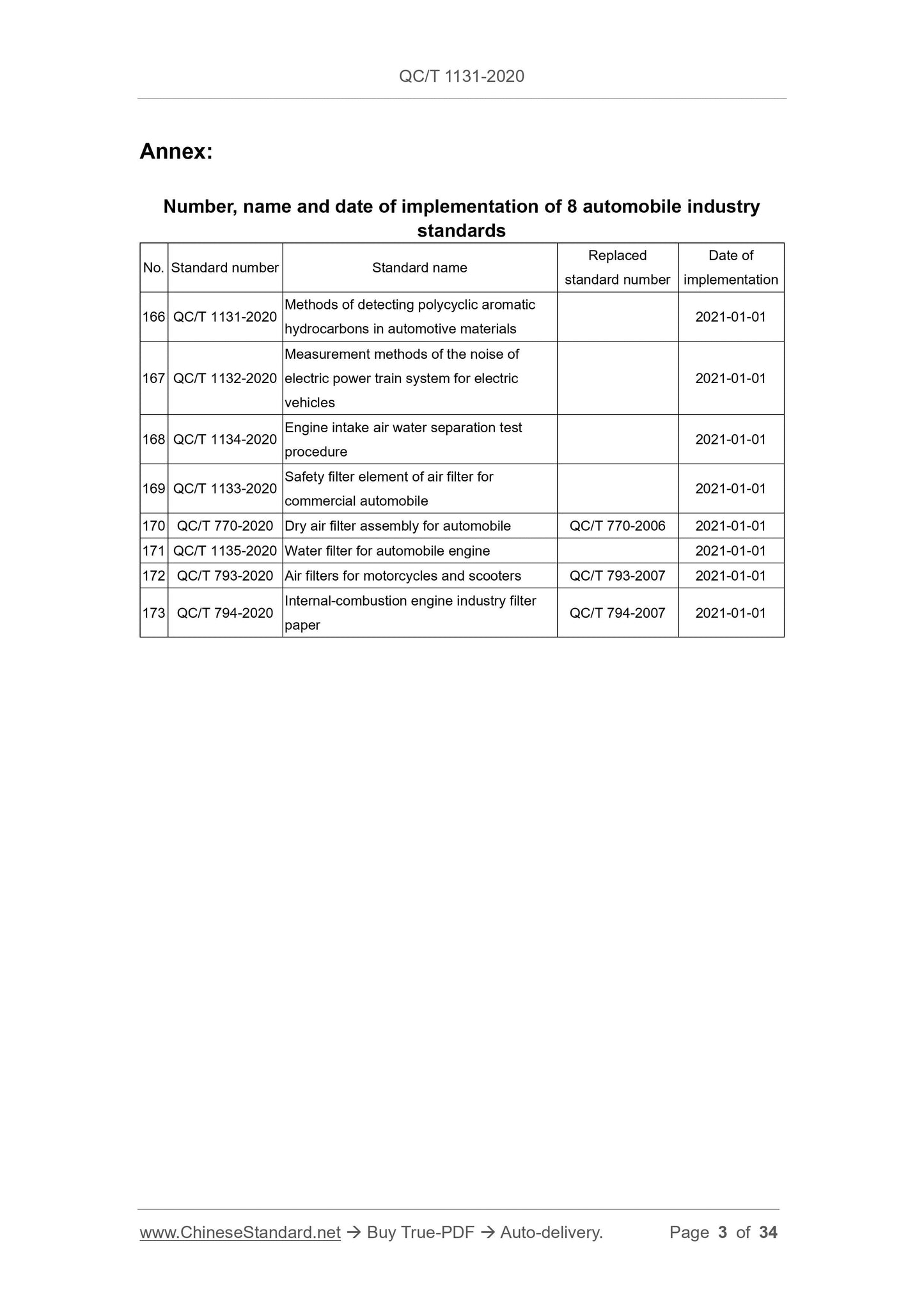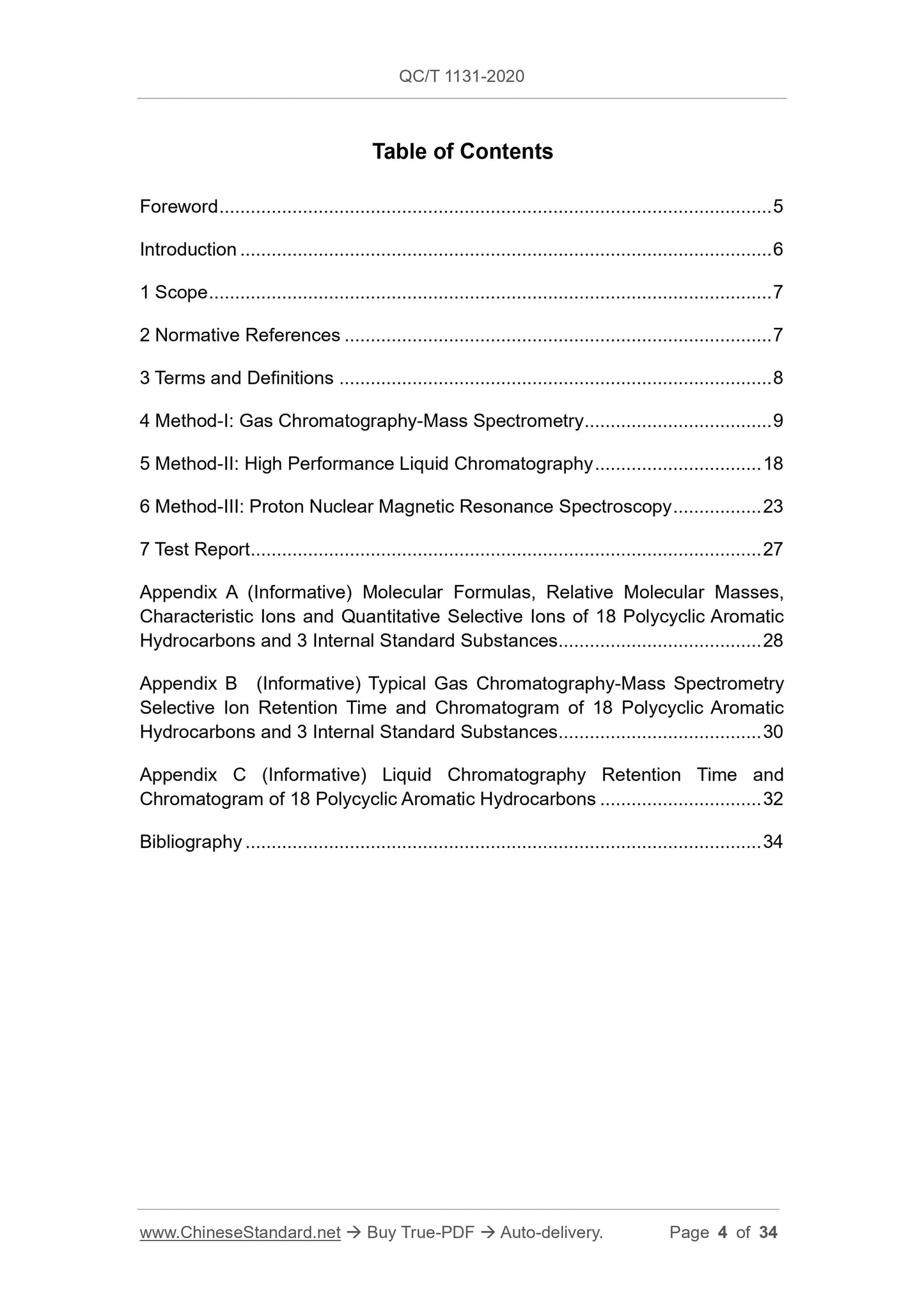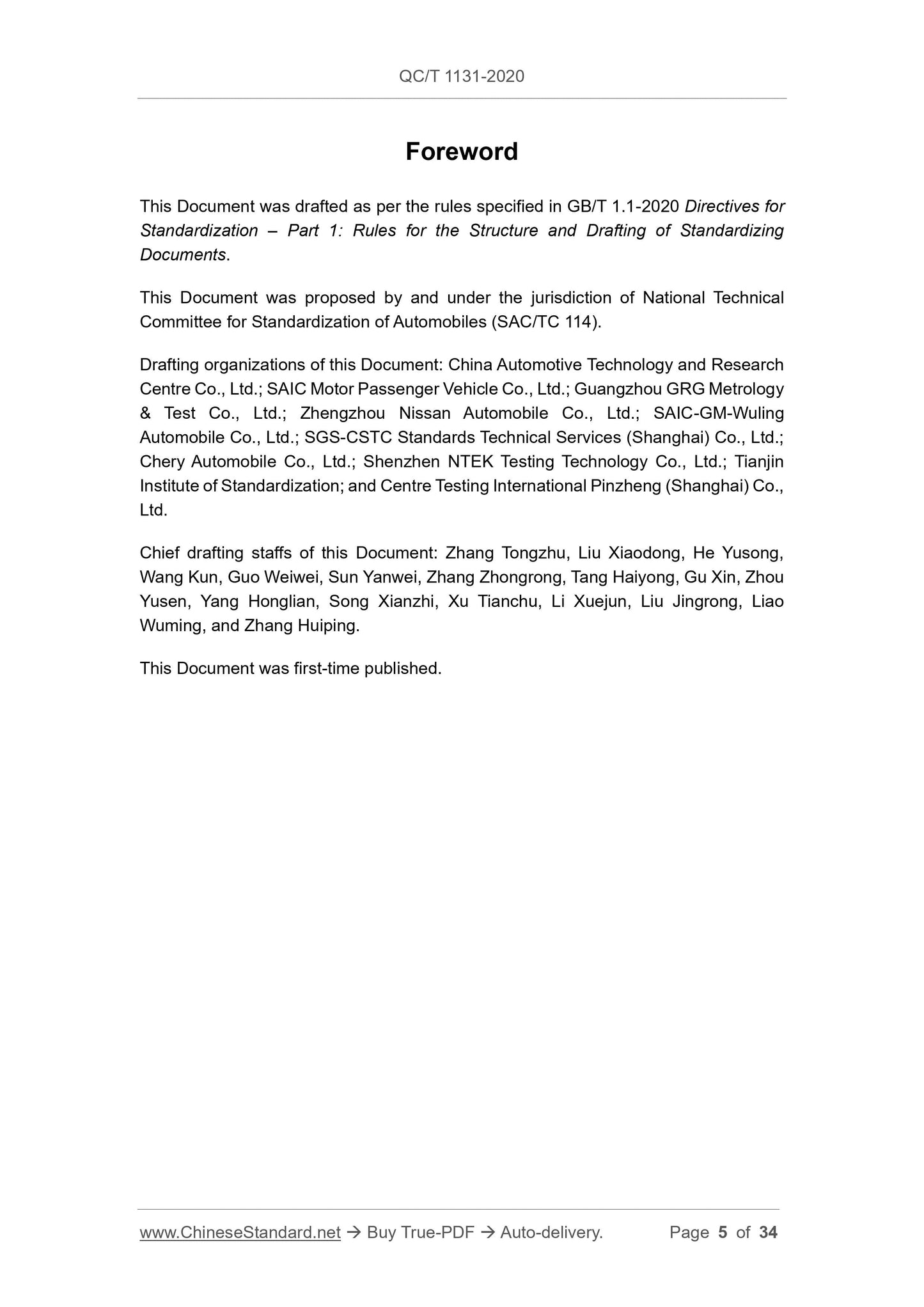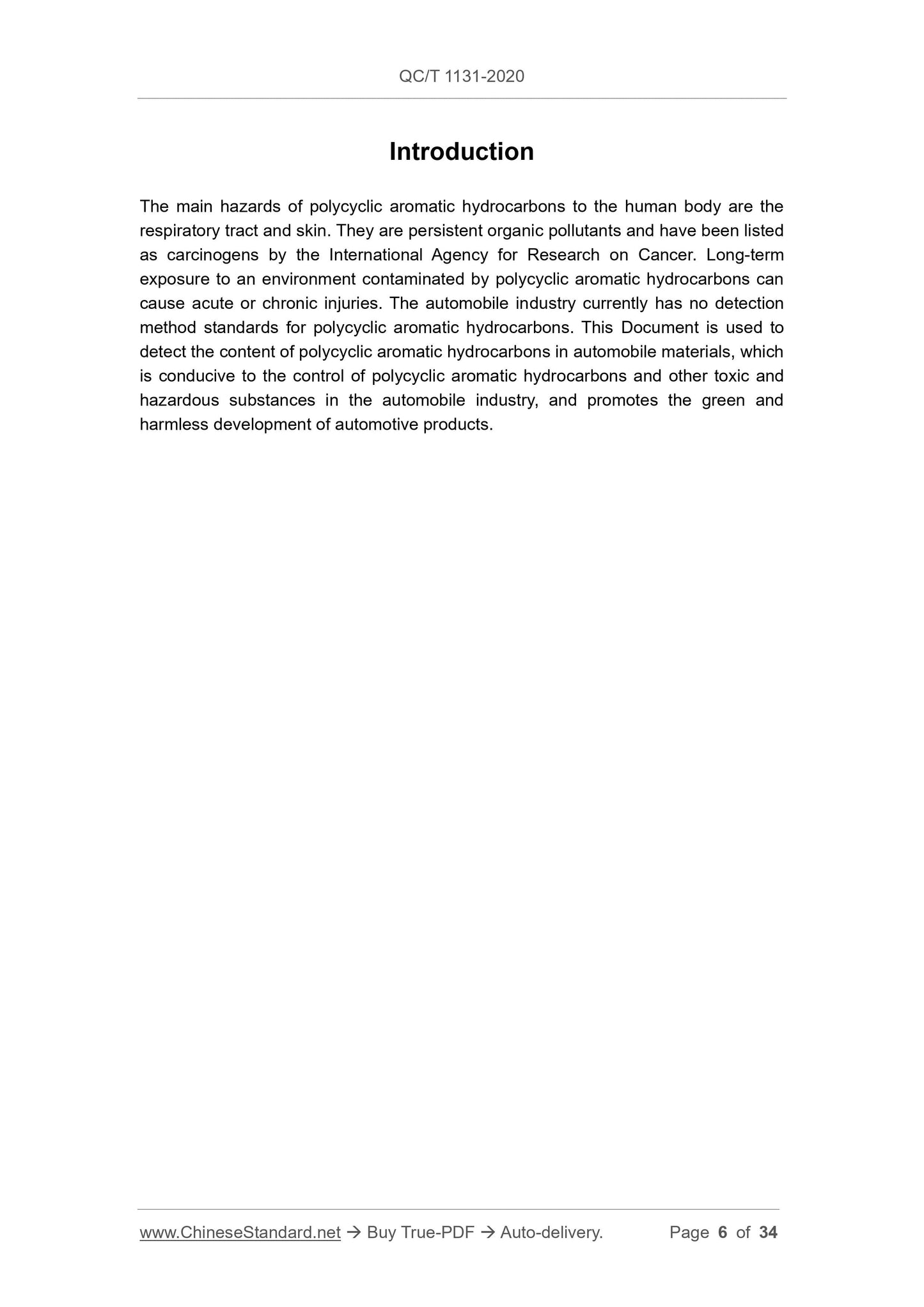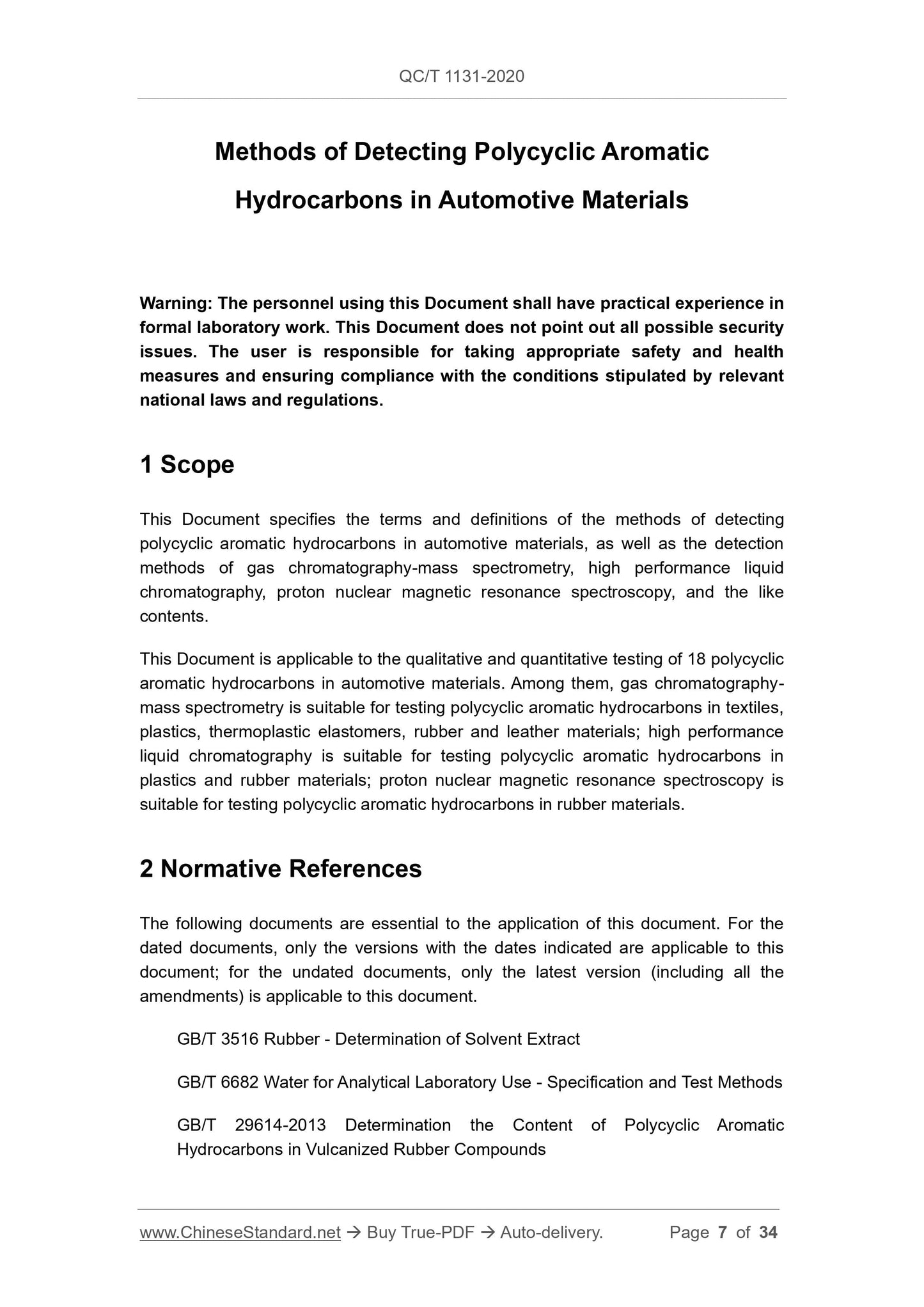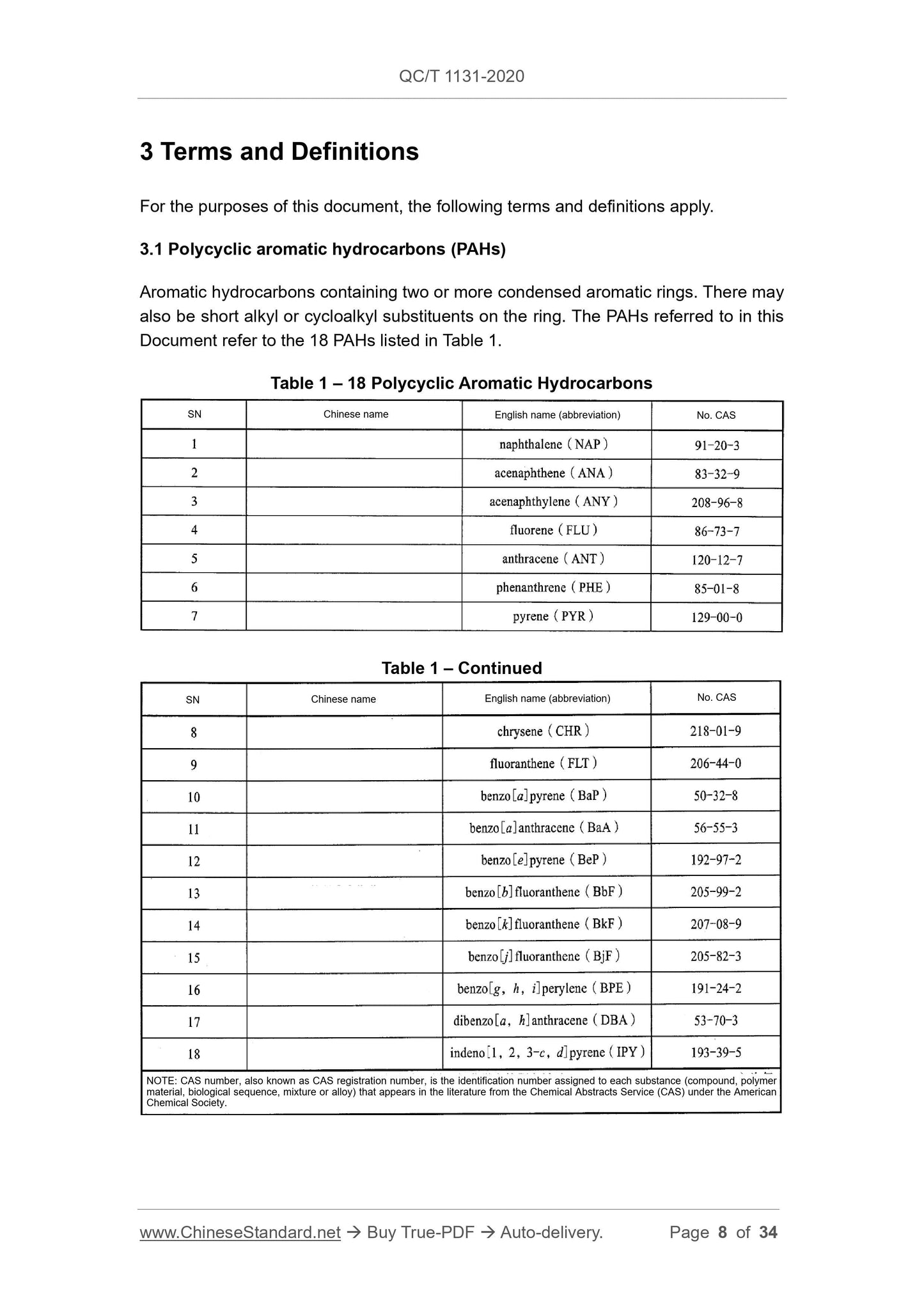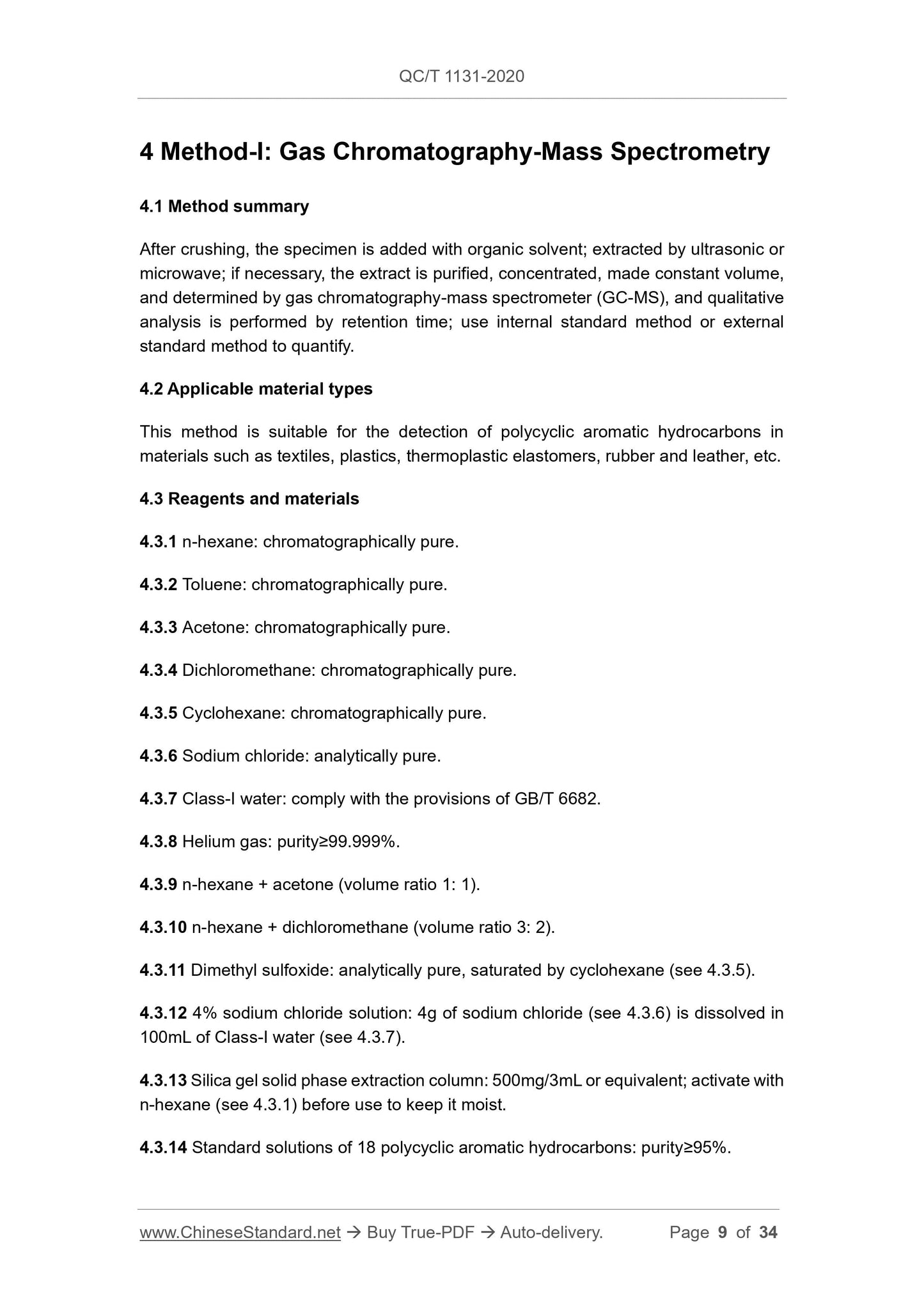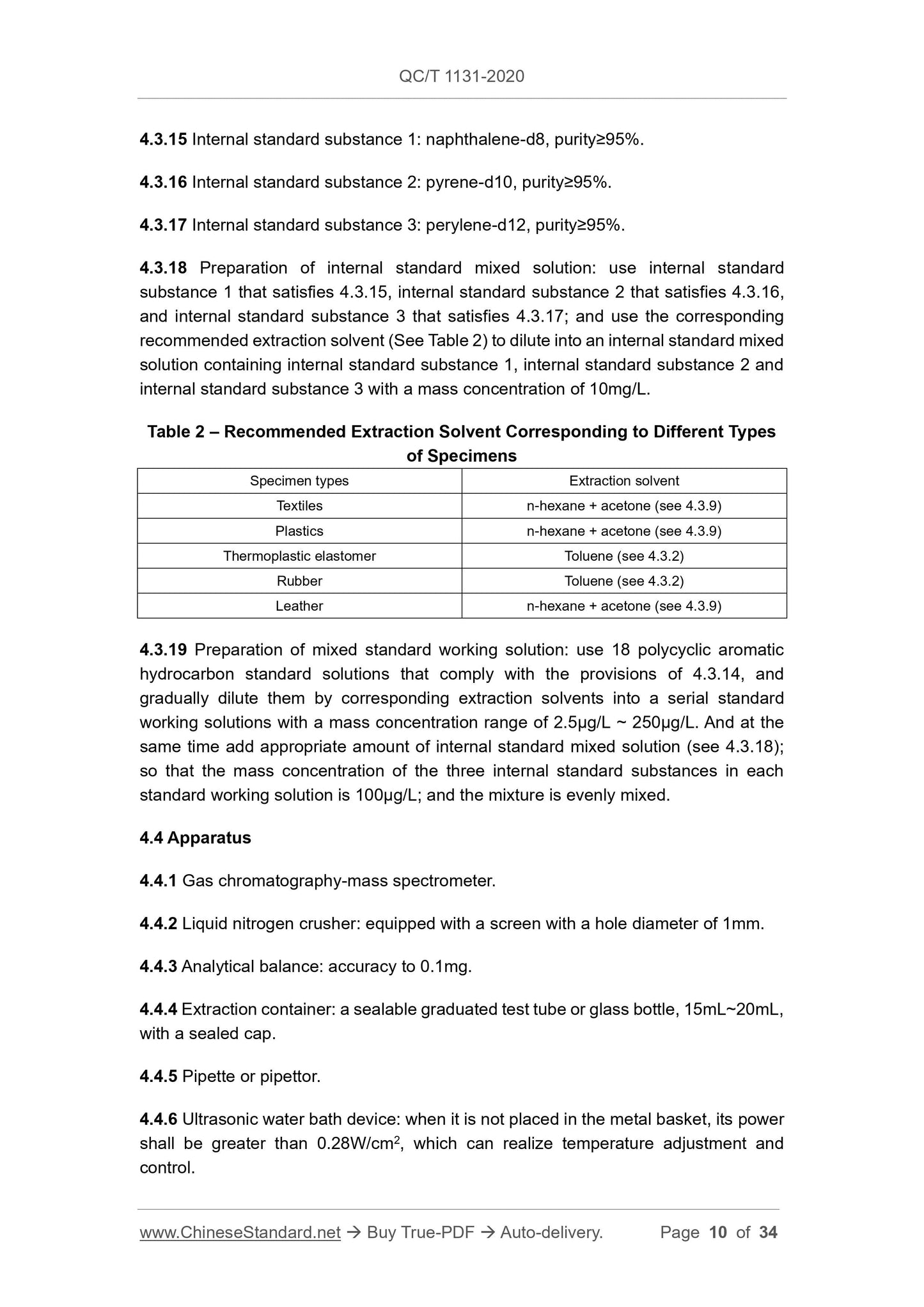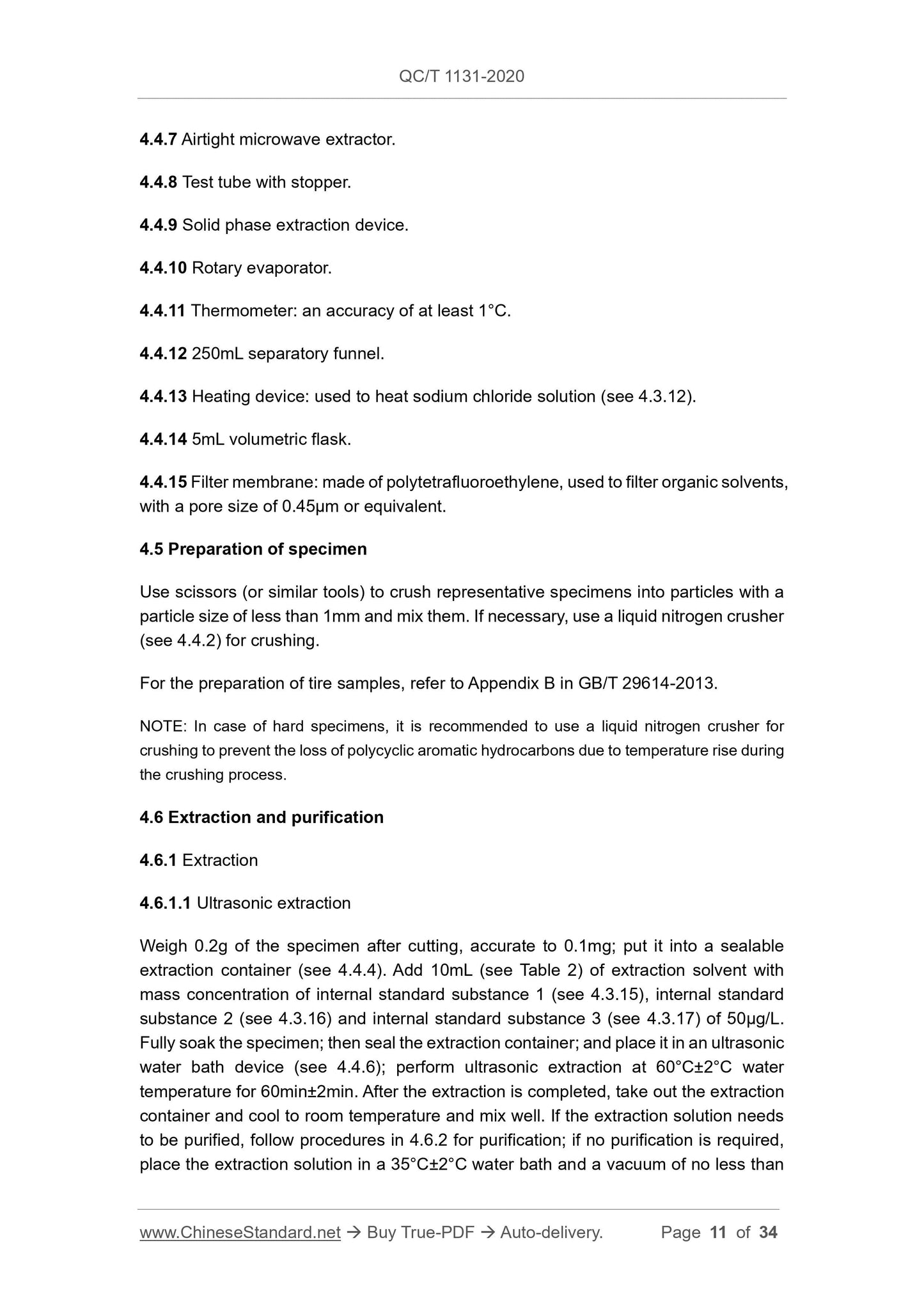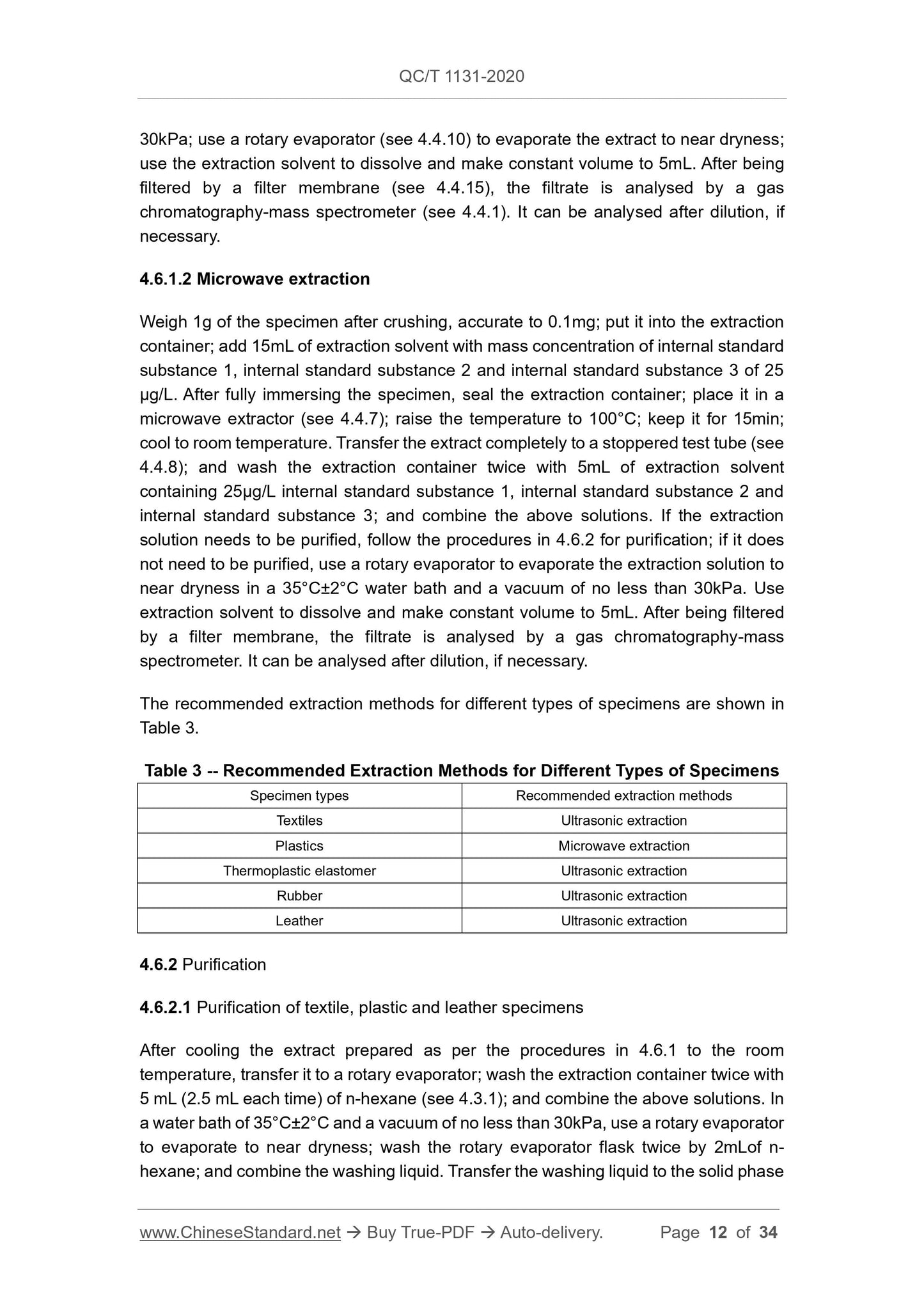1
/
of
12
PayPal, credit cards. Download editable-PDF & invoice in 1 second!
QC/T 1131-2020 English PDF (QCT1131-2020)
QC/T 1131-2020 English PDF (QCT1131-2020)
Regular price
$380.00 USD
Regular price
Sale price
$380.00 USD
Unit price
/
per
Shipping calculated at checkout.
Couldn't load pickup availability
Delivery: 3 seconds. Download true-PDF + Invoice.
Get QUOTATION in 1-minute: Click QC/T 1131-2020
Historical versions: QC/T 1131-2020
Preview True-PDF (Reload/Scroll if blank)
QC/T 1131-2020: Methods of Detecting Polycyclic Aromatic Hydrocarbons in Automotive Materials
QC/T 1131-2020
QC
AUTOMOBILE INDUSTRY STANDARD
OF THE PEOPLE’S REPUBLIC OF CHINA
ICS 43.040
T 40
Methods of Detecting Polycyclic Aromatic
Hydrocarbons in Automotive Materials
ISSUED ON: AUGUST 31, 2020
IMPLEMENTED ON: JANUARY 01, 2021
Issued by: Ministry of Industry and Information Technology of PRC
Table of Contents
Foreword ... 5
Introduction ... 6
1 Scope ... 7
2 Normative References ... 7
3 Terms and Definitions ... 8
4 Method-I: Gas Chromatography-Mass Spectrometry ... 9
5 Method-II: High Performance Liquid Chromatography ... 18
6 Method-III: Proton Nuclear Magnetic Resonance Spectroscopy ... 23
7 Test Report ... 27
Appendix A (Informative) Molecular Formulas, Relative Molecular Masses,
Characteristic Ions and Quantitative Selective Ions of 18 Polycyclic Aromatic
Hydrocarbons and 3 Internal Standard Substances... 28
Appendix B (Informative) Typical Gas Chromatography-Mass Spectrometry
Selective Ion Retention Time and Chromatogram of 18 Polycyclic Aromatic
Hydrocarbons and 3 Internal Standard Substances... 30
Appendix C (Informative) Liquid Chromatography Retention Time and
Chromatogram of 18 Polycyclic Aromatic Hydrocarbons ... 32
Bibliography ... 34
Methods of Detecting Polycyclic Aromatic
Hydrocarbons in Automotive Materials
Warning: The personnel using this Document shall have practical experience in
formal laboratory work. This Document does not point out all possible security
issues. The user is responsible for taking appropriate safety and health
measures and ensuring compliance with the conditions stipulated by relevant
national laws and regulations.
1 Scope
This Document specifies the terms and definitions of the methods of detecting
polycyclic aromatic hydrocarbons in automotive materials, as well as the detection
methods of gas chromatography-mass spectrometry, high performance liquid
chromatography, proton nuclear magnetic resonance spectroscopy, and the like
contents.
This Document is applicable to the qualitative and quantitative testing of 18 polycyclic
aromatic hydrocarbons in automotive materials. Among them, gas chromatography-
mass spectrometry is suitable for testing polycyclic aromatic hydrocarbons in textiles,
plastics, thermoplastic elastomers, rubber and leather materials; high performance
liquid chromatography is suitable for testing polycyclic aromatic hydrocarbons in
plastics and rubber materials; proton nuclear magnetic resonance spectroscopy is
suitable for testing polycyclic aromatic hydrocarbons in rubber materials.
2 Normative References
The following documents are essential to the application of this document. For the
dated documents, only the versions with the dates indicated are applicable to this
document; for the undated documents, only the latest version (including all the
amendments) is applicable to this document.
GB/T 3516 Rubber - Determination of Solvent Extract
GB/T 6682 Water for Analytical Laboratory Use - Specification and Test Methods
GB/T 29614-2013 Determination the Content of Polycyclic Aromatic
Hydrocarbons in Vulcanized Rubber Compounds
4 Method-I: Gas Chromatography-Mass Spectrometry
4.1 Method summary
After crushing, the specimen is added with organic solvent; extracted by ultrasonic or
microwave; if necessary, the extract is purified, concentrated, made constant volume,
and determined by gas chromatography-mass spectrometer (GC-MS), and qualitative
analysis is performed by retention time; use internal standard method or external
standard method to quantify.
4.2 Applicable material types
This method is suitable for the detection of polycyclic aromatic hydrocarbons in
materials such as textiles, plastics, thermoplastic elastomers, rubber and leather, etc.
4.3 Reagents and materials
4.3.1 n-hexane: chromatographically pure.
4.3.2 Toluene: chromatographically pure.
4.3.3 Acetone: chromatographically pure.
4.3.4 Dichloromethane: chromatographically pure.
4.3.5 Cyclohexane: chromatographically pure.
4.3.6 Sodium chloride: analytically pure.
4.3.7 Class-I water: comply with the provisions of GB/T 6682.
4.3.8 Helium gas: purity≥99.999%.
4.3.9 n-hexane + acetone (volume ratio 1: 1).
4.3.10 n-hexane + dichloromethane (volume ratio 3: 2).
4.3.11 Dimethyl sulfoxide: analytically pure, saturated by cyclohexane (see 4.3.5).
4.3.12 4% sodium chloride solution: 4g of sodium chloride (see 4.3.6) is dissolved in
100mL of Class-I water (see 4.3.7).
4.3.13 Silica gel solid phase extraction column: 500mg/3mL or equivalent; activate with
n-hexane (see 4.3.1) before use to keep it moist.
4.3.14 Standard solutions of 18 polycyclic aromatic hydrocarbons: purity≥95%.
4.4.7 Airtight microwave extractor.
4.4.8 Test tube with stopper.
4.4.9 Solid phase extraction device.
4.4.10 Rotary evaporator.
4.4.11 Thermometer: an accuracy of at least 1°C.
4.4.12 250mL separatory funnel.
4.4.13 Heating device: used to heat sodium chloride solution (see 4.3.12).
4.4.14 5mL volumetric flask.
4.4.15 Filter membrane: made of polytetrafluoroethylene, used to filter organic solvents,
with a pore size of 0.45µm or equivalent.
4.5 Preparation of specimen
Use scissors (or similar tools) to crush representative specimens into particles with a
particle size of less than 1mm and mix them. If necessary, use a liquid nitrogen crusher
(see 4.4.2) for crushing.
For the preparation of tire samples, refer to Appendix B in GB/T 29614-2013.
NOTE: In case of hard specimens, it is recommended to use a liquid nitrogen crusher for
crushing to prevent the loss of polycyclic aromatic hydrocarbons due to temperature rise during
the crushing process.
4.6 Extraction and purification
4.6.1 Extraction
4.6.1.1 Ultrasonic extraction
Weigh 0.2g of the specimen after cutting, accurate to 0.1mg; put it into a sealable
extraction container (see 4.4.4). Add 10mL (see Table 2) of extraction solvent with
mass concentration of internal standard substance 1 (see 4.3.15), internal standard
substance 2 (see 4.3.16) and internal standard substance 3 (see 4.3.17) of 50μg/L.
Fully soak the specimen; then seal the extraction container; and place it in an ultrasonic
water bath device (see 4.4.6); perform ultrasonic extraction at 60°C±2°C water
temperature for 60min±2min. After the extraction is completed, take out the extraction
container and cool to room temperature and mix well. If the extraction solution needs
to be purified, follow procedures in 4.6.2 for purification; if no purification is required,
place the extraction solution in a 35°C±2°C water bath and a vacuum of no less than
extraction column (see 4.3.13); and control the flow rate to 1 drop/2s. Then add 5mL
of n-hexane to rinse; discard the washing liquid. Elute the specimen by 5 mL of n-
hexane + dichloromethane (see 4.3.10) solution; and collect the eluate. Use a rotary
evaporator to evaporate the eluate to near dryness in a water bath of 35°C±2°C and a
vacuum of no less than 30kPa. Dissolve it by n-hexane + acetone and make constant
volume to 5mL. After being filtered by a filter membrane, the filtrate is analysed by a
gas chromatography-mass spectrometer. If necessary, analysis can be performed after
dilution.
4.6.2.2 Purification of thermoplastic elastomer specimens
Use a rotary evaporator (heating temperature no higher than 40°C) to concentrate the
extract prepared as per the procedures in 4.6.1 to about 1mL; add 10mL of
cyclohexane (see 4.3.5) to dissolve the specimen; transfer th...
Get QUOTATION in 1-minute: Click QC/T 1131-2020
Historical versions: QC/T 1131-2020
Preview True-PDF (Reload/Scroll if blank)
QC/T 1131-2020: Methods of Detecting Polycyclic Aromatic Hydrocarbons in Automotive Materials
QC/T 1131-2020
QC
AUTOMOBILE INDUSTRY STANDARD
OF THE PEOPLE’S REPUBLIC OF CHINA
ICS 43.040
T 40
Methods of Detecting Polycyclic Aromatic
Hydrocarbons in Automotive Materials
ISSUED ON: AUGUST 31, 2020
IMPLEMENTED ON: JANUARY 01, 2021
Issued by: Ministry of Industry and Information Technology of PRC
Table of Contents
Foreword ... 5
Introduction ... 6
1 Scope ... 7
2 Normative References ... 7
3 Terms and Definitions ... 8
4 Method-I: Gas Chromatography-Mass Spectrometry ... 9
5 Method-II: High Performance Liquid Chromatography ... 18
6 Method-III: Proton Nuclear Magnetic Resonance Spectroscopy ... 23
7 Test Report ... 27
Appendix A (Informative) Molecular Formulas, Relative Molecular Masses,
Characteristic Ions and Quantitative Selective Ions of 18 Polycyclic Aromatic
Hydrocarbons and 3 Internal Standard Substances... 28
Appendix B (Informative) Typical Gas Chromatography-Mass Spectrometry
Selective Ion Retention Time and Chromatogram of 18 Polycyclic Aromatic
Hydrocarbons and 3 Internal Standard Substances... 30
Appendix C (Informative) Liquid Chromatography Retention Time and
Chromatogram of 18 Polycyclic Aromatic Hydrocarbons ... 32
Bibliography ... 34
Methods of Detecting Polycyclic Aromatic
Hydrocarbons in Automotive Materials
Warning: The personnel using this Document shall have practical experience in
formal laboratory work. This Document does not point out all possible security
issues. The user is responsible for taking appropriate safety and health
measures and ensuring compliance with the conditions stipulated by relevant
national laws and regulations.
1 Scope
This Document specifies the terms and definitions of the methods of detecting
polycyclic aromatic hydrocarbons in automotive materials, as well as the detection
methods of gas chromatography-mass spectrometry, high performance liquid
chromatography, proton nuclear magnetic resonance spectroscopy, and the like
contents.
This Document is applicable to the qualitative and quantitative testing of 18 polycyclic
aromatic hydrocarbons in automotive materials. Among them, gas chromatography-
mass spectrometry is suitable for testing polycyclic aromatic hydrocarbons in textiles,
plastics, thermoplastic elastomers, rubber and leather materials; high performance
liquid chromatography is suitable for testing polycyclic aromatic hydrocarbons in
plastics and rubber materials; proton nuclear magnetic resonance spectroscopy is
suitable for testing polycyclic aromatic hydrocarbons in rubber materials.
2 Normative References
The following documents are essential to the application of this document. For the
dated documents, only the versions with the dates indicated are applicable to this
document; for the undated documents, only the latest version (including all the
amendments) is applicable to this document.
GB/T 3516 Rubber - Determination of Solvent Extract
GB/T 6682 Water for Analytical Laboratory Use - Specification and Test Methods
GB/T 29614-2013 Determination the Content of Polycyclic Aromatic
Hydrocarbons in Vulcanized Rubber Compounds
4 Method-I: Gas Chromatography-Mass Spectrometry
4.1 Method summary
After crushing, the specimen is added with organic solvent; extracted by ultrasonic or
microwave; if necessary, the extract is purified, concentrated, made constant volume,
and determined by gas chromatography-mass spectrometer (GC-MS), and qualitative
analysis is performed by retention time; use internal standard method or external
standard method to quantify.
4.2 Applicable material types
This method is suitable for the detection of polycyclic aromatic hydrocarbons in
materials such as textiles, plastics, thermoplastic elastomers, rubber and leather, etc.
4.3 Reagents and materials
4.3.1 n-hexane: chromatographically pure.
4.3.2 Toluene: chromatographically pure.
4.3.3 Acetone: chromatographically pure.
4.3.4 Dichloromethane: chromatographically pure.
4.3.5 Cyclohexane: chromatographically pure.
4.3.6 Sodium chloride: analytically pure.
4.3.7 Class-I water: comply with the provisions of GB/T 6682.
4.3.8 Helium gas: purity≥99.999%.
4.3.9 n-hexane + acetone (volume ratio 1: 1).
4.3.10 n-hexane + dichloromethane (volume ratio 3: 2).
4.3.11 Dimethyl sulfoxide: analytically pure, saturated by cyclohexane (see 4.3.5).
4.3.12 4% sodium chloride solution: 4g of sodium chloride (see 4.3.6) is dissolved in
100mL of Class-I water (see 4.3.7).
4.3.13 Silica gel solid phase extraction column: 500mg/3mL or equivalent; activate with
n-hexane (see 4.3.1) before use to keep it moist.
4.3.14 Standard solutions of 18 polycyclic aromatic hydrocarbons: purity≥95%.
4.4.7 Airtight microwave extractor.
4.4.8 Test tube with stopper.
4.4.9 Solid phase extraction device.
4.4.10 Rotary evaporator.
4.4.11 Thermometer: an accuracy of at least 1°C.
4.4.12 250mL separatory funnel.
4.4.13 Heating device: used to heat sodium chloride solution (see 4.3.12).
4.4.14 5mL volumetric flask.
4.4.15 Filter membrane: made of polytetrafluoroethylene, used to filter organic solvents,
with a pore size of 0.45µm or equivalent.
4.5 Preparation of specimen
Use scissors (or similar tools) to crush representative specimens into particles with a
particle size of less than 1mm and mix them. If necessary, use a liquid nitrogen crusher
(see 4.4.2) for crushing.
For the preparation of tire samples, refer to Appendix B in GB/T 29614-2013.
NOTE: In case of hard specimens, it is recommended to use a liquid nitrogen crusher for
crushing to prevent the loss of polycyclic aromatic hydrocarbons due to temperature rise during
the crushing process.
4.6 Extraction and purification
4.6.1 Extraction
4.6.1.1 Ultrasonic extraction
Weigh 0.2g of the specimen after cutting, accurate to 0.1mg; put it into a sealable
extraction container (see 4.4.4). Add 10mL (see Table 2) of extraction solvent with
mass concentration of internal standard substance 1 (see 4.3.15), internal standard
substance 2 (see 4.3.16) and internal standard substance 3 (see 4.3.17) of 50μg/L.
Fully soak the specimen; then seal the extraction container; and place it in an ultrasonic
water bath device (see 4.4.6); perform ultrasonic extraction at 60°C±2°C water
temperature for 60min±2min. After the extraction is completed, take out the extraction
container and cool to room temperature and mix well. If the extraction solution needs
to be purified, follow procedures in 4.6.2 for purification; if no purification is required,
place the extraction solution in a 35°C±2°C water bath and a vacuum of no less than
extraction column (see 4.3.13); and control the flow rate to 1 drop/2s. Then add 5mL
of n-hexane to rinse; discard the washing liquid. Elute the specimen by 5 mL of n-
hexane + dichloromethane (see 4.3.10) solution; and collect the eluate. Use a rotary
evaporator to evaporate the eluate to near dryness in a water bath of 35°C±2°C and a
vacuum of no less than 30kPa. Dissolve it by n-hexane + acetone and make constant
volume to 5mL. After being filtered by a filter membrane, the filtrate is analysed by a
gas chromatography-mass spectrometer. If necessary, analysis can be performed after
dilution.
4.6.2.2 Purification of thermoplastic elastomer specimens
Use a rotary evaporator (heating temperature no higher than 40°C) to concentrate the
extract prepared as per the procedures in 4.6.1 to about 1mL; add 10mL of
cyclohexane (see 4.3.5) to dissolve the specimen; transfer th...
Share
